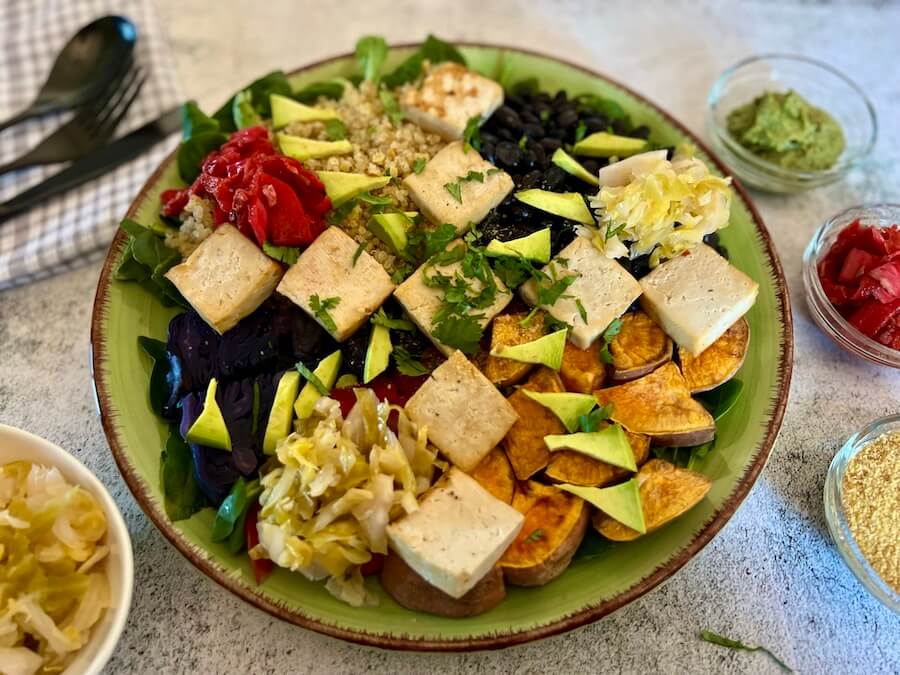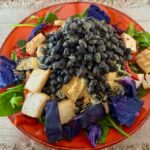Is a WFPB diet good for OMAD? So you wanna do OMAD? (Sounds a bit like going walkabouts or something haha!)
But OMAD is an acronym for one meal a day.
Great news – if you’re already eating a WFPB diet, I think you’ll find this a much smoother ride.
Because when we eat WFPB, we’re already used to eating healthy complete meals. You know, nutrient dense, where everything on the plate counts towards our health and is bursting with phytonutrients.
And we don’t have to contend with sugar – you know, sugar, and the cravings and headaches it brings.
So if you fancy diving into OMAD (or another protocol of intermittent fasting), vamos amigo, let’s do this thing!
I’ve been intermittent fasting for eons. More years than I can tell.
Sometimes it wasn’t even intentionally, I just didn’t get hungry in the mornings so I skipped breakfast. Not sure if that can technically qualify as IF but if not, it was pretty similar.
Since then I’ve graduated to longer fasts. The longest fast I’ve done so far, when I didn’t eat any food was my 5 day water fast, which actually blew my mind and opened me up to the possibilities.
It was actually a five-and-a-half-days, but let’s not split hairs.
Table of Content
Introduction to WFPB and OMAD diets
Vegan WFPB
WFPB stands for whole foods plant based and OMAD stands for one meal a day.
Both of these types of eating have huge health benefits to offer. If you don’t eat WFPB already, you may like to take a look at this guide to whole foods plant based eating.
On the WFPB diet we include all whole foods. Some people eat WFPB and aren’t vegan, though they get most of their calories and nutrition from plants, and definitely no dairy. For the purposes of this post though, WFPB refers to VEGAN WFPB, which is the way I personally choose to eat.
Of course haha.
To summarise a vegan WFPB diet, it will include all grains, nuts, pulses, beans, vegetables, fruit, tofu and tempeh. Some people also include olive oil, though a more strict WFPB approach is to remove processed oils and rely on whole foods for natural fats. This is sometimes referred to as WFPBNO (whole foods plant based no oil).
So if we adhere to WFPBNO, we eat olives but skip the olive oil (because oil’s calorie dense and nutrient poor).
This is a divided topic and personal choice. I stopped cooking with oil and I’m happy this way.
I also tend not to use raw oil very much and I definitely don’t plaster it on my salad any more. But if I felt a dish would benefit from a dash of raw extra virgin olive oil, then I would eat it.
Benefits of WFPB vegan diet
- WFPB is the optimum diet for heart health: wfpb can prevent, manage and treat chronic heart disease with phenomenal results. WFPB lowers bad cholesterol and blood pressure.
- Eating a WFPB diet fights inflammation and reduces the risk of chronic disease such as type 2 diabetes, autoimmune conditions and some forms of cancer.
- Great for weight loss managements.
- High in fibre and great for the gut. Helps to promote a healthy digestive system, especially when coupled with probiotics in the form of fermented foods like kimchi and sauerkraut.
- Better for the animals and for the environment.
- A WFPB may be linked to longevity.
OMAD Diet
One meal a day is the strictest form of intermittent fasting. It is literally abounding with health benefits and when you start to think about it, you realise it’s actually the way we were designed. Not OMAD per se, but to go periods of time without food.
Other forms of intermittent fasting (IF) are 16:8, 18:6, 20:4 with OMAD coming in at the top with a ratio of 23:1 so we fast for 23 hours and eat for 1.
When in a fasted state, our system switches over to burning fat, our bodies go into autophagy where they recyle damaged, weak or old cells and replace them with new ones and growth hormone is released. Blood sugar levels drop and insulin sensitivity rises.
The details of whether OMAD is a good idea long term is a more complex subject (tip: it’s best to switch your fasting habits around, for example: do OMAD for 3 days of the week and choose another protocol for the other days).
Benefits of OMAD
- Autophagy kicks in after about 17 hours with no food as the body hunts out and destroys the damaged, diseased and weakened cells. The process of autophagy’s so powerful that it can stop a virus in its tracks, so that it can’t reproduce.
- Fat-burning: OMAD burns fat like nobody’s business. Ok, so there’s a limit on how much energy can be transferred from fat to energy in any one day, so it’s important not to demand too much too fast. But do it right and your body-fat will begin to decrease, resulting in a lower BMI.
- OMAD improves sensitivity to insulin, regulates blood-sugar levels and reduces the risk of diabetes type 2.
- Weight loss! Of course.
- Many people report increased mental sharpness, probably as a result of the autophagy.
- Cheaper shopping bills.
OMAD and WFPB Combined
There are ways to do OMAD badly.
For example, eating just one meal a day and then making that meal a poor choice of processed foods and low nutritional value is likely to lead to problems in the long run.
Another issue is thinking that, because you can eat anything on the OMAD diet (is this really true?), you can then eat more than a day’s worth of food all in one sitting.
Neither of these concerns are likely to happen if you’re used to eating WFPB.
Fistly, your meals are exploding with phytonutrients, complex carbs, natural fats, protein and fibre, and secondly, it’s unlikely that you’d try to eat triple quantity of these types of food.
Refined sugar leads to cravings and in the WFPB we omit processed sugars.
But if we do find ourselves craving that meal and over-stuffing our faces, remember it’s best to celebrate the journey, the space between the meals, rather than key ourselves up for that grand banquet, in a deprived-of-food type of mentality.
We also don’t want to control what we eat. Eat a feast. Fill our stomach and appease our appetite.
So combining OMAD and WFPB brings you a double hit of healthy eats. Just be sure to include plenty of plant protein in your OMAD meal.
What to Eat for Your WFPB OMAD?
My favourite way of eating on OMAD is similar to a buddha bowl. I have various ingredients cooked and ready to go onto the plate and I renew the ones which run out, as they run out.
So I’ll make some quinoa or lentils or split peas.
Plus I’ll cook some tofu and sweet potato in the air-fryer and some black beans or chickpeas from the rice cooker.
There’s always a green leaf to go at the bottom, either spinach leaves or lambs leaves. I have sauerkraut and kimchi to put on the side and a generous mountain of ground flax or hemp seeds on top.
To top it all off, a lovely avocado and a few spoon fulls of cilantro pesto. I love eating this way and it covers all my nutritional needs. For dessert I have a decaffeinated coffee and 2 pieces of dark chocolate or some fruit.
And then I’m full.
Until the next day comes around.
And until then, make sure to drink a lot of water between your OMAD meals.
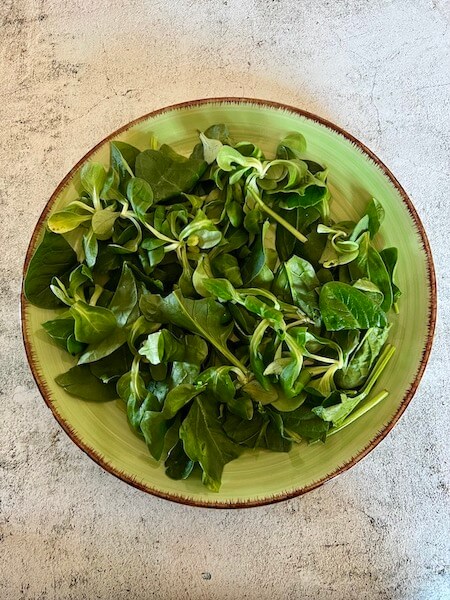
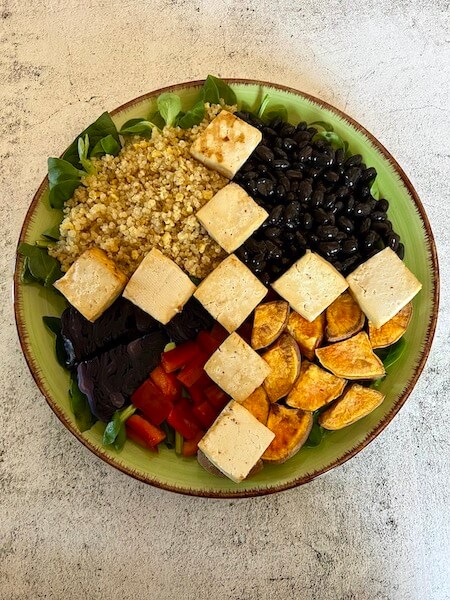
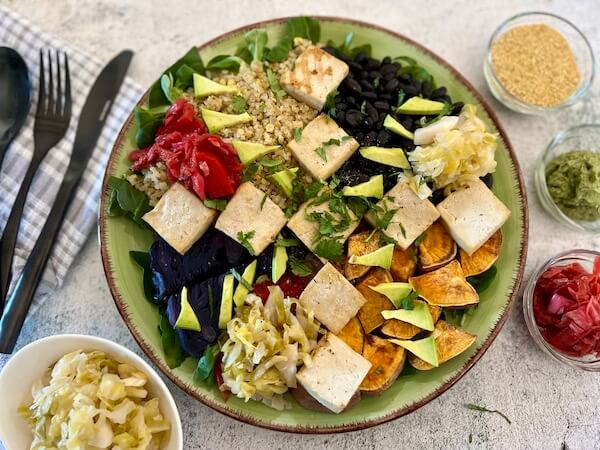
Conclusion on Is a WFPB Diet Good for OMAD?
WFPB is, for me, the best diet you could possibly choose to follow. Why? Well not only because of the science which backs it up, but also because of the common sense: it’s about eating real food. Things that are whole foods, rather than things that are numbers or chemicals or additives or sugars.
Added to that the biologically sound habit of fasting and you have a recipe for success. There are amazing benefits of fasting even if you don’t choose OMAD. For some people 18:6 or 16:8 might be easier to fit into their lifestyle.
The bottom line is, do OMAD when it fits well and do 16:8 when it doesn’t.
You can almost already feel the difference in the waistband of your trousers!
Go for it!
